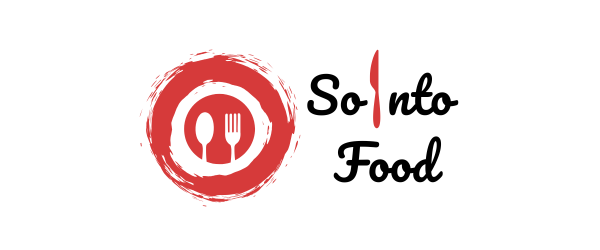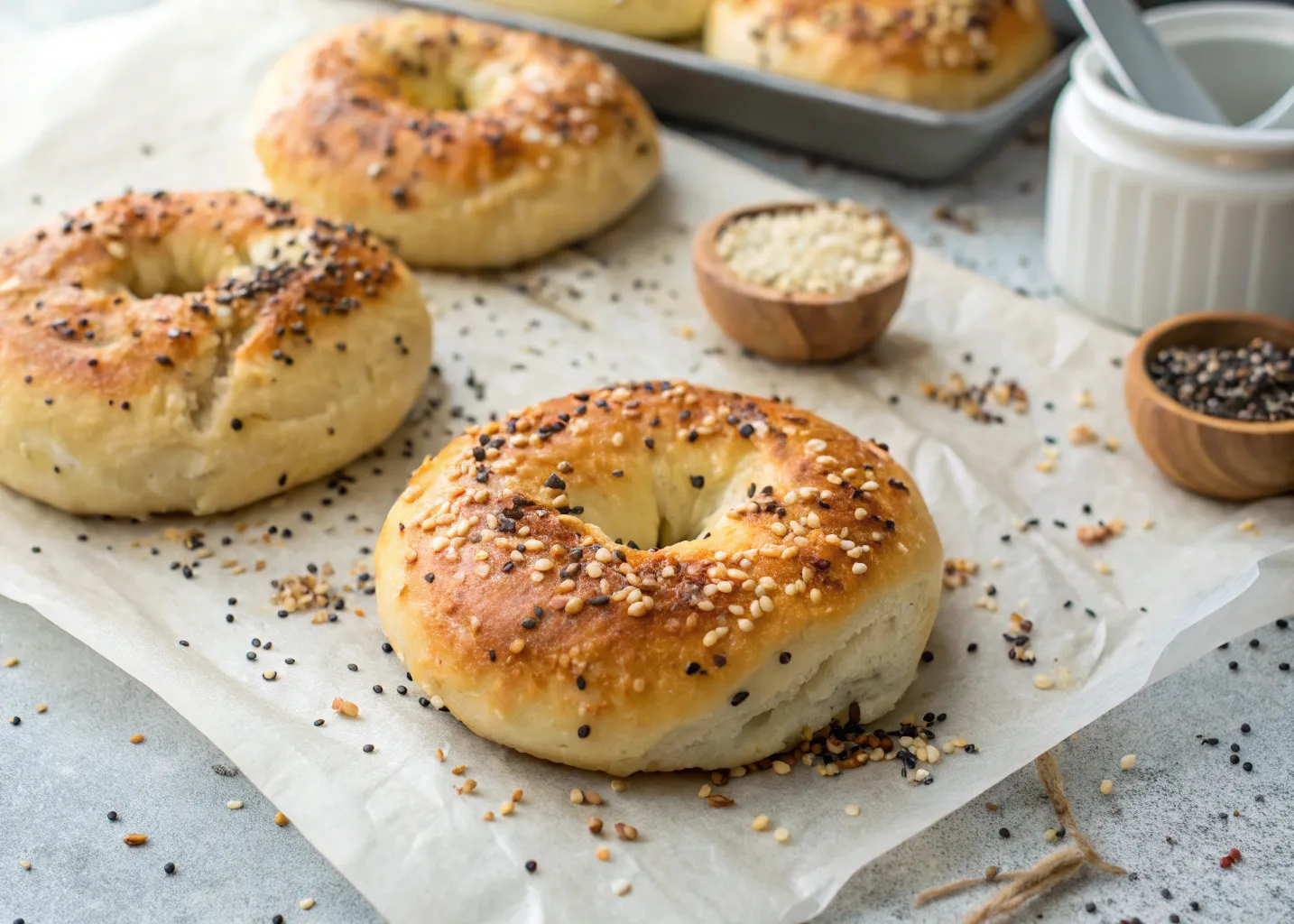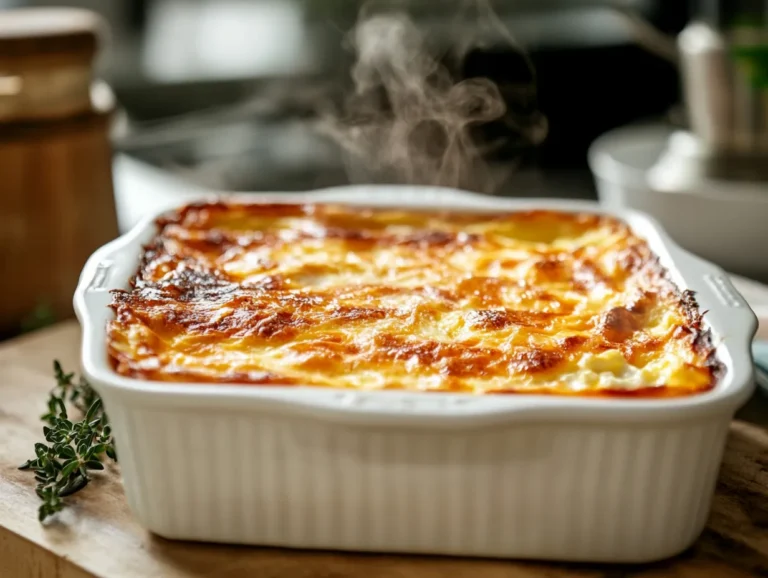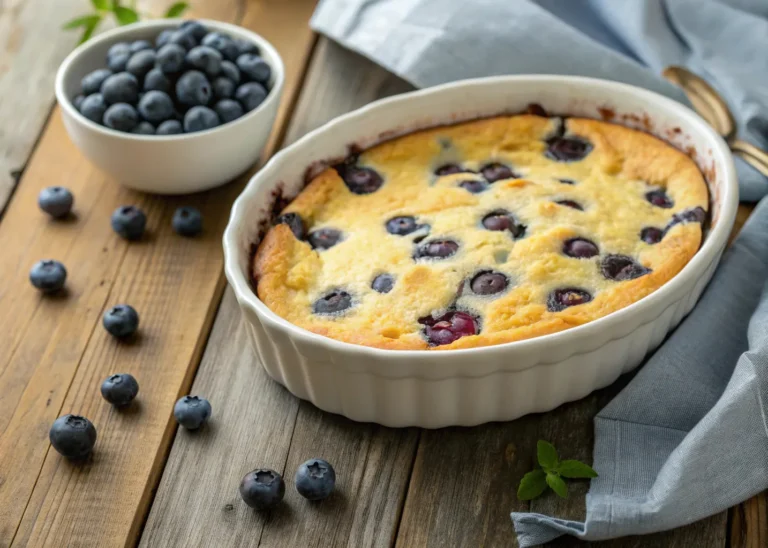If you’re on the hunt for a protein-packed, no-fuss breakfast that actually tastes good and fuels your day, cottage cheese bagels are about to be your new go-to. These bagels are soft on the inside, golden on the outside, and packed with wholesome protein thanks to the magic of cottage cheese. They’re also incredibly easy to make — no yeast, no rise time, no long prep — just mix, shape, and bake.
This recipe is perfect for busy mornings, post-workout meals, or anytime you need a satisfying bite without sacrificing your health goals. In this article, we’ll walk you through everything from the ingredients to storage tips and even answer the most common questions people ask about cottage cheese bagels. Whether you’re a health nut, a curious foodie, or just someone who wants better breakfast options, you’re in the right place.
Looking for inspiration? Try more healthy recipes like this to keep your meal routine both simple and satisfying.
Let’s dive into why these bagels are blowing up in kitchens everywhere.
Why Cottage Cheese Bagels Are the Game-Changer in Healthy Baking
What Makes These Bagels Stand Out
Cottage cheese might not be the first ingredient that comes to mind when you think of bagels — but that’s exactly what makes this recipe unique. By swapping in cottage cheese, you’re not just adding a subtle creaminess to the dough; you’re loading each bite with slow-digesting casein protein that keeps you full longer.
Here’s why this recipe stands out in the world of healthy baking:
- No yeast needed: Skip the rising and proofing. These bagels are ready in under 30 minutes.
- Protein-rich: Cottage cheese gives each bagel a protein punch, making them perfect for fitness lovers and anyone focused on eating clean.
- Lower in carbs: Compared to traditional bagels, these are lighter on the carbs while still being filling.
- Customizable: Whether you like ‘em sweet or savory, the base recipe adapts to your cravings.
- Minimal ingredients: You only need a handful of pantry staples. Seriously.
These aren’t your typical bakery bagels — they’re cleaner, smarter, and built for the modern kitchen.
Benefits of Using Cottage Cheese Instead of Traditional Ingredients
Here’s why cottage cheese belongs in your baking lineup.
1. High in Protein: Traditional store-bought bagels are usually heavy on carbs but light on protein. Cottage cheese turns that around. Just half a cup can pack in up to 14 grams of protein, giving your baked goods a nutritious boost depending on the brand you use.
2. Moisture and texture: Cottage cheese keeps your dough moist without needing butter or oil. It adds a gentle softness to the crumb of the bagel while keeping the exterior crisp.
3. Fewer additives: Store-bought bagels often contain preservatives or fillers. With homemade cottage cheese bagels, you control exactly what goes in.
4. Digestive-friendly: Many people find cottage cheese easier to digest than milk or cream. Plus, it contains live cultures that may help gut health (depending on the type you buy).
5. Versatility: This isn’t just a breakfast item. Cottage cheese bagels are great for sandwiches, toast alternatives, or even pizza bagel bases.
In short, cottage cheese gives these bagels a nutrition upgrade and a texture you’ll want to keep making again and again.
Ingredients You’ll Need for Cottage Cheese Bagels
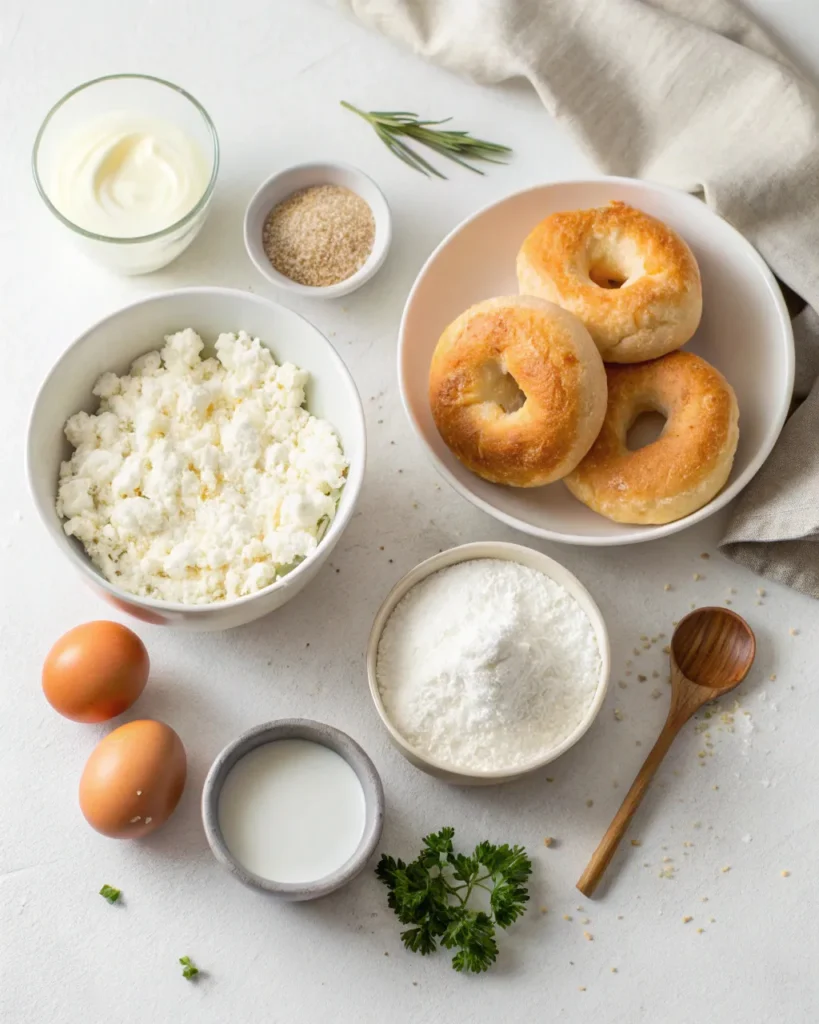
Simple, Pantry-Friendly Ingredients List
One of the best things about this recipe is how short and simple the ingredient list is. You won’t need anything fancy or hard to pronounce — just a few kitchen basics and, of course, cottage cheese.
Here’s what you’ll need to make about 4–6 medium-sized cottage cheese bagels:
| Ingredient | Quantity | Notes |
|---|---|---|
| Cottage cheese (low-fat) | 1 cup (240g) | Full-fat works too for a richer taste |
| All-purpose flour | 1 ¼ cups (150g) | Can sub with whole wheat or gluten-free flour |
| Baking powder | 2 tsp | Aluminum-free preferred for clean taste |
| Salt | ½ tsp | Optional, but enhances flavor |
| Egg (for egg wash) | 1 large | For that classic golden top |
| Optional seasonings/toppings | To taste | Think: everything bagel seasoning, sesame, garlic, etc. |
That’s it! No yeast, no sugar, no oil. Every ingredient pulls its weight in creating a fluffy, satisfying bagel that doesn’t take all day to make.
Tips on Choosing the Best Cottage Cheese
While you can technically use any cottage cheese in this recipe, the kind you choose does affect both texture and flavor. Here’s what to keep in mind:
1. Go for small curd over large curd
Smaller curds blend into the dough more easily and create a smoother bagel texture. Large curds might leave tiny lumps, which some people enjoy — it’s all about personal preference.
2. Choose full-fat for richness, low-fat for leaner macros
Using full-fat cottage cheese results in softer, richer bagels with a more indulgent texture. For a lighter option that still delivers great taste, low-fat cottage cheese works just as well—ideal if you’re tracking fat or macros.
3. Check the label for clean ingredients
Choose cottage cheese made with simple ingredients like milk, live cultures, salt, and possibly a touch of cream. Avoid brands that include additives like gums, starches, or artificial flavors.
4. Drain if it’s too watery
If your cottage cheese is super wet, spoon it into a fine mesh strainer or cheesecloth and let it sit for 5–10 minutes before adding it to the dough. This helps avoid excess moisture and sticky dough.
Using a good-quality cottage cheese will make a noticeable difference in the outcome. This ingredient is the star of the recipe, so it’s worth choosing a good one.
How to Make Cottage Cheese Bagels from Scratch
Step-by-Step Instructions (with Measurements)
No special equipment. No kneading machines. Just a bowl, a spoon, and about 30 minutes from start to finish. Let’s walk through this easy cottage cheese bagel recipe step-by-step.
Step 1: Preheat your oven
- Set your oven to 375°F (190°C) and line a baking sheet with parchment paper or a silicone baking mat. This prevents sticking and helps even baking.
Step 2: Mix your dry ingredients
- In a large mixing bowl, whisk together:
- 1¼ cups all-purpose flour
- 2 teaspoons baking powder
- ½ teaspoon salt (optional)
Mix well to evenly distribute the baking powder and salt.
Step 3: Add the cottage cheese
- Spoon in 1 cup of cottage cheese (drained slightly if watery).
- Use a spoon or silicone spatula to fold the cottage cheese into the flour mixture until a shaggy dough forms.
Step 4: Bring it all together
- Lightly flour a clean surface and dump your dough onto it.
- Knead the dough gently for about 1–2 minutes, just until it comes together. Don’t overwork it.
Tip: The dough will be a bit sticky. Lightly flour your hands to prevent sticking, but don’t add too much flour or the bagels may become dry.
Step 5: Shape your bagels
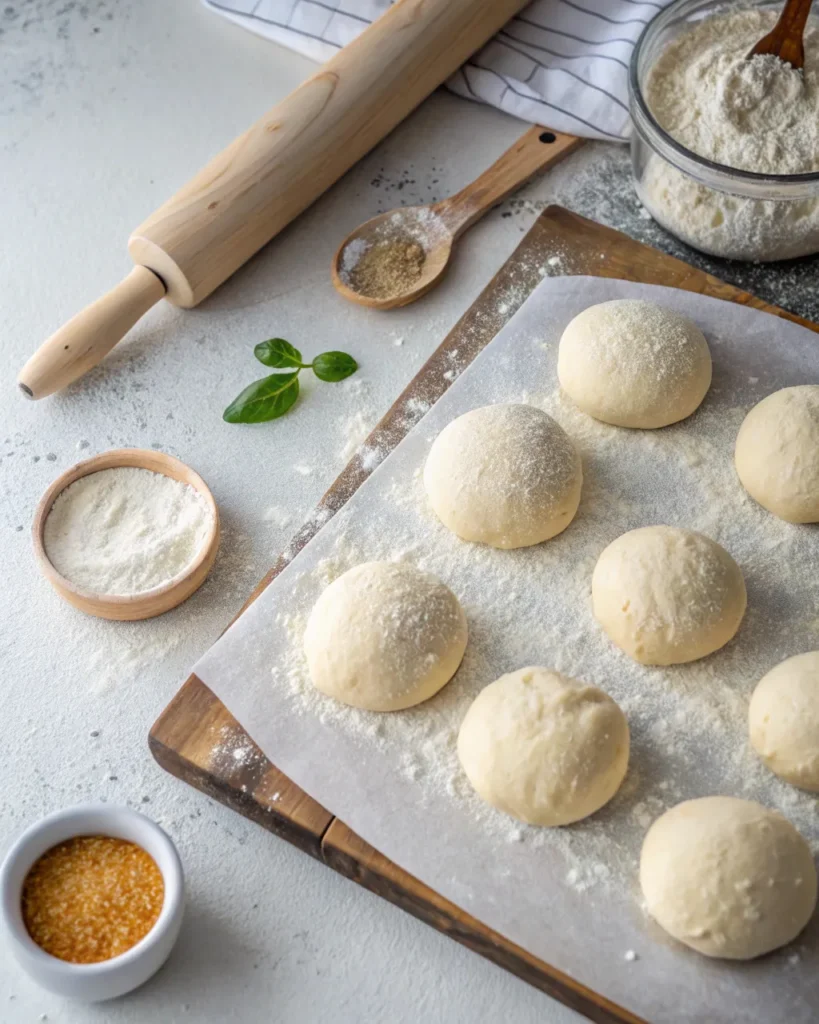
- Divide the dough into 4 to 6 equal portions.
- Shape each portion into a smooth ball, then gently poke a hole through the center with your finger.
- Gently stretch the center to create a bagel shape.
Pro Tip: Want a neater look? Roll into logs and connect the ends. Either method works!
Step 6: Apply egg wash and toppings
- Crack 1 egg into a small bowl and beat well.
- Brush the bagel tops with egg wash using a pastry brush to achieve a glossy, golden crust.
- Add your favorite toppings — everything bagel seasoning, sesame seeds, poppy seeds, or even shredded cheese.
Step 7: Bake
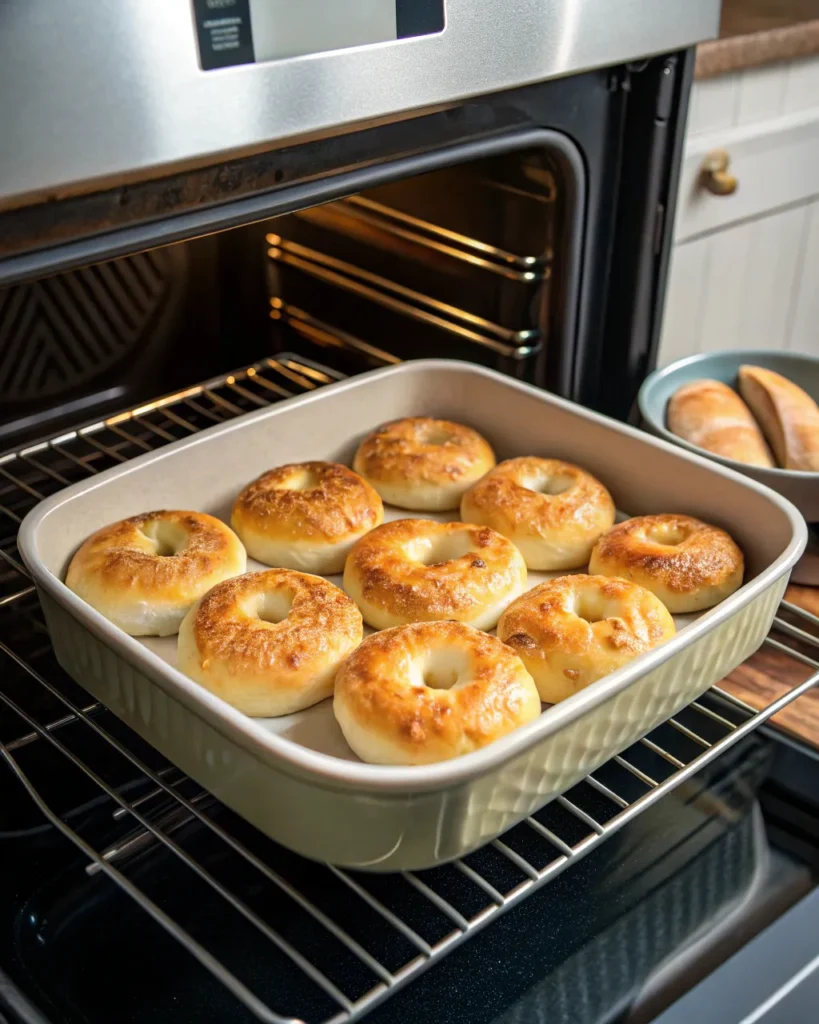
- Arrange the shaped and egg-washed bagels on your prepared baking sheet.
- Bake in your preheated oven for 20–25 minutes, or until golden brown and slightly firm to the touch.
They’ll puff up in the oven and form a golden crust while remaining soft and tender inside.
Step 8: Cool and serve
- Take them out of the oven and let them cool on a wire rack for 5–10 minutes before slicing or serving.
And that’s it — fresh, warm cottage cheese bagels straight from your oven.
Pro Tips for First-Time Bakers
Even if you’re new to baking bagels, this recipe is very beginner-friendly. Here are a few simple tips to help you get great results:
✅ Don’t overmix
Once your dough comes together, stop mixing. Overworking can make the bagels tough.
✅ Watch the moisture
Too-wet dough? Add 1 tablespoon of flour at a time until it’s manageable. Too dry? Add a teaspoon of milk or water.
✅ Use parchment
Cottage cheese bagels can stick if placed directly on a pan. Parchment makes removal a breeze.
✅ Toast leftovers
The day after baking, slice and toast the bagels for extra crunch. They’re great with avocado, nut butter, or even just a pat of butter.
Variations and Customizations for Every Taste
One of the best parts about homemade cottage cheese bagels is how easy they are to customize. The base recipe is neutral, meaning you can take these bagels in either a savory or sweet direction depending on your mood, meal, or dietary preferences.
Let’s explore some delicious twists to make your bagels anything but boring.
Sweet vs Savory Bagel Variations
Whether you’re craving a light breakfast, a hearty sandwich base, or a post-gym snack, these variations will inspire your next batch.
🍓 Sweet Bagel Ideas:
Perfect for breakfast, brunch, or a healthy dessert.
- Cinnamon Raisin: Add 1 tsp ground cinnamon and 2 tbsp raisins directly into the dough before shaping.
- Blueberry Vanilla: Fold in ¼ cup of fresh or frozen blueberries and ½ tsp vanilla extract.
- Honey Oat: Brush bagels with honey before baking and sprinkle with rolled oats.
- Maple Walnut: Stir in 1 tablespoon of crushed walnuts and a light drizzle of maple syrup.
Top with almond butter or Greek yogurt for a protein-packed sweet treat.
For a sweeter option, try spreading almond butter or pairing your bagel with our protein-packed cottage cheese chocolate mousse for a dessert-inspired twist.
🧄 Savory Bagel Ideas:
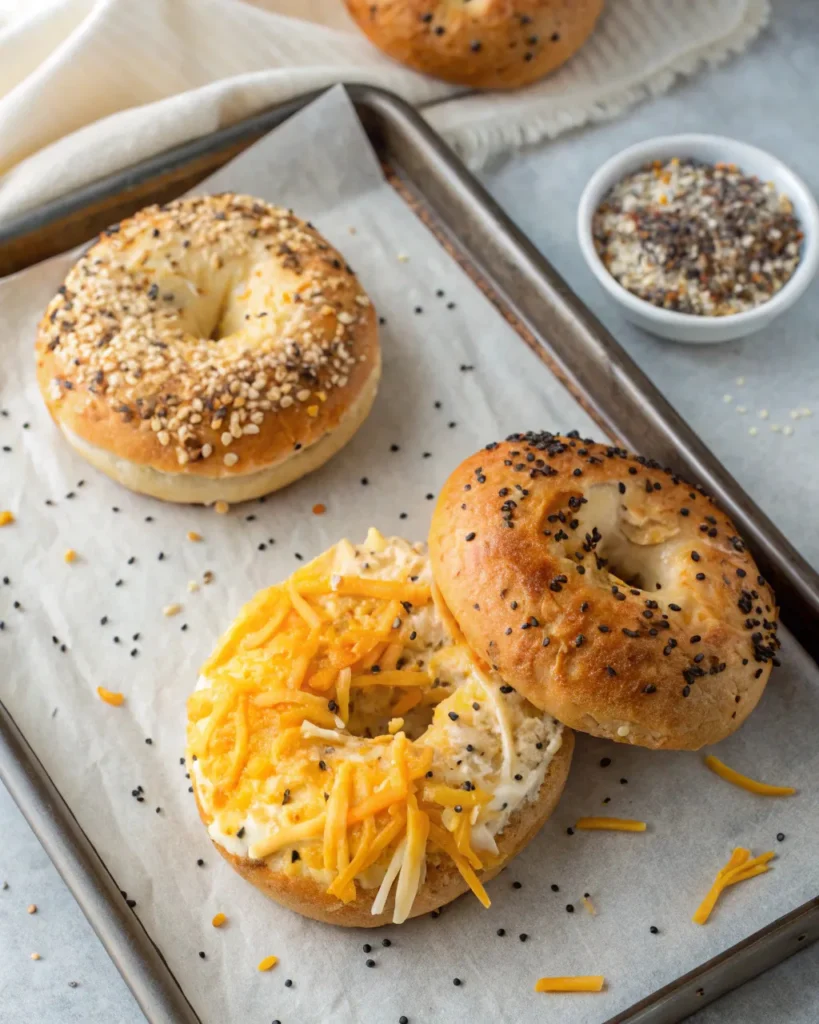
Great for sandwiches, snacking, or a protein-heavy breakfast.
- Everything Seasoned: Top with everything bagel seasoning — a classic for a reason.
- Cheddar Jalapeño: Mix shredded sharp cheddar and chopped jalapeños into the dough.
- Garlic Herb: Add 1 teaspoon of garlic powder, ½ teaspoon of dried thyme, and some chopped fresh parsley to the dough.
- Sun-Dried Tomato & Basil: Add chopped sun-dried tomatoes and a touch of dried basil for a Mediterranean twist.
Pair with hummus, scrambled eggs, or smoked salmon (if desired).
High-Protein Add-ins and Toppings Ideas
If you’re aiming to increase the protein content even more — especially for fitness, weight loss, or macro tracking — these add-ins and toppings won’t disappoint:
Add-ins to Mix into Dough:
- Chia seeds (1 tbsp): Adds protein and fiber
- Hemp hearts (1–2 tbsp): Mild flavor and high omega-3s
- Whey protein powder (1 scoop): Use unflavored or lightly flavored vanilla
- Shredded part-skim mozzarella (¼ cup): Melts beautifully inside the dough
Toppings After Baking:
- Greek yogurt + sliced fruit
- Mashed avocado + chili flakes
- Cottage cheese + sliced tomato & pepper
- Hard-boiled egg slices + mustard or sriracha
Tip: Balance your macros by combining these bagels with healthy fats and fiber-rich toppings.
These customizations let you turn a simple recipe into a meal-prep powerhouse, a grab-and-go breakfast, or even a gourmet brunch option. Whether you’re eating low carb, high protein, or somewhere in between — cottage cheese bagels adapt to your goals.
Nutritional Value of Cottage Cheese Bagels
When it comes to bagels, people often think “carbs, carbs, carbs.” But with cottage cheese bagels, the game completely changes. Thanks to the high-protein base and no added sugar, these bagels provide real nutrition without the crash.
Let’s take a closer look at how these homemade bagels fuel your body the smart way.
Macronutrient Breakdown Per Bagel
Here’s the average nutritional content for one medium-sized cottage cheese bagel (based on a recipe yield of 6 and using low-fat cottage cheese):
| Nutrient | Amount |
|---|---|
| Calories | ~160–180 kcal |
| Protein | 13–16g |
| Carbohydrates | 20–22g |
| Fat | 3–5g |
| Fiber | 1–2g |
| Sugar | <2g (naturally occurring) |
These values can vary depending on the exact ingredients used (like type of flour or cottage cheese). For lower carb or higher protein, simply adjust with almond flour or protein powder.
Why It’s a Smart Choice for Fitness and Weight-Loss
Let’s be real — most store-bought bagels are dense, high in refined carbs, and lacking in both fiber and protein. That’s fine as a treat, but not ideal if you’re trying to feel satisfied and energized all day.
Cottage cheese bagels flip that narrative. Here’s how:
1. High Protein = Longer Fullness
Each bagel contains roughly 13–16 grams of protein, thanks to cottage cheese and optional add-ins like chia or whey. That’s nearly triple the amount in many regular bagels.
More protein = fewer cravings later.
2. Balanced Macros
By combining a moderate amount of carbs with protein and a touch of healthy fat, you get steady energy release — no sugar spike, no crash.
3. Lower Calorie Density
Because you’re not using oil or added sugar, these bagels stay light and nutrient-dense. You get volume without blowing your calorie goals.
4. Supports Lean Muscle Goals
Post-workout meal? Check. These bagels help repair and rebuild muscle when paired with other clean proteins or amino acids.
5. Supports Blood Sugar Balance
The protein and fiber help blunt the glycemic impact of the flour, making them a better option for those mindful of blood sugar or insulin levels.
In short, these aren’t empty calories. Cottage cheese bagels give you a flavorful, satisfying, and nutritionally dense option that works hard for your health goals — whether you’re looking to build muscle, shed fat, or simply eat better.
If you’re focused on fitness or managing macros, explore natural weight-friendly recipe ideas that align with your goals.
Cottage Cheese Bagels vs Traditional Bagels
If you’re wondering whether switching from regular bagels to cottage cheese bagels is worth it — the answer is a loud yes. Not only are they easier to make, but they’re also far more aligned with today’s health-conscious lifestyle.
Let’s break down how they compare on the most important factors: ingredients, nutrition, taste, and versatility.
Ingredient Comparison Table
Here’s how the basic ingredient profiles stack up:
| Feature | Traditional Bagels | Cottage Cheese Bagels |
|---|---|---|
| Main ingredients | Refined flour, yeast, sugar, water, oil | Cottage cheese, flour, baking powder, egg |
| Requires yeast? | Yes | No |
| Prep time | 1.5 to 2 hours (includes proofing) | 30 minutes total |
| Added sugar | Usually contains sugar or malt syrup | None (naturally low sugar) |
| Oil or butter | Often included | Not needed |
| Protein content | Low (4–5g per serving) | High (13–16g per serving) |
| Customizable? | Somewhat | Extremely |
With fewer ingredients and no rise time, cottage cheese bagels offer unmatched convenience and health benefits.
Taste, Texture, and Nutrition Differences
Taste
- Traditional bagels have a mildly sweet, chewy texture with a neutral flavor.
- Cottage cheese bagels are mild, slightly tangy (from the cheese), and tender inside. They taste wholesome and satisfying, with no doughy aftertaste.
Texture
- Regular bagels are denser and require boiling before baking.
- Cottage cheese bagels are softer and fluffier, but still have a golden crust — especially with a good egg wash.
They’re best described as a blend between a soft bread roll and a traditional bagel.
Nutrition
- Traditional bagels are higher in empty carbs and often low in fiber or protein.
- Cottage cheese bagels are nutrient-dense, with high protein, fewer carbs, and better macronutrient balance overall.
Here’s a side-by-side nutrient snapshot for comparison:
| Nutrient (Per Bagel) | Traditional Bagel (100g) | Cottage Cheese Bagel (100g) |
|---|---|---|
| Calories | ~260 | ~160–180 |
| Protein | 4–5g | 13–16g |
| Carbohydrates | 45–50g | 20–22g |
| Fat | 1–2g | 3–5g |
| Sugar | 4–6g | <2g |
Bottom line?
Cottage cheese bagels aren’t just a healthier alternative — they’re quicker, simpler, and more nutritious, all without sacrificing taste or texture.
Storage and Meal Prep Tips for Cottage Cheese Bagels
So you’ve baked a fresh batch of warm, protein-packed cottage cheese bagels — now what? Whether you’re planning to eat them throughout the week or save them for future breakfasts, knowing how to store and prep them properly will help you keep that soft, fluffy texture and fresh flavor.
Let’s cover how to store, reheat, and even freeze these bagels without losing quality.
How to Store for Maximum Freshness
Room Temperature (Short-Term):
If you plan to eat your bagels within 1–2 days, store them in an airtight container or zip-top bag at room temperature.
- Wrap them in parchment paper first, then place in the container to avoid moisture buildup.
- Keep in a cool, dry spot away from sunlight.
Tip: Avoid storing them in the refrigerator. That speeds up staling due to the starches crystallizing.
Fridge (If Absolutely Necessary):
If your home is very warm or humid, you can refrigerate them for up to 3–4 days, but reheat before eating to restore softness.
Freezing and Reheating Tips
Want to bake in bulk? These bagels freeze beautifully. Here’s how to freeze and enjoy them later:
❄️ How to Freeze:
- Let bagels cool completely at room temperature.
- Slice in half (if desired) for easier toasting later.
- Wrap each bagel tightly in plastic wrap or foil.
- Place the wrapped bagels into a freezer-safe container or storage bag.
- Label with the date — they’ll stay fresh for up to 3 months.
🔥 How to Reheat:
- From frozen: Toast directly from the freezer using a toaster or toaster oven.
- Microwave option: Wrap in a paper towel and microwave on medium for 30–40 seconds, then toast for crispiness.
- Oven method: Bake at 350°F (175°C) for 8–10 minutes until warmed through.
Bonus tip: If you added toppings like cheese or seeds, reheat in a toaster oven to crisp without burning.
Meal Prep Like a Pro
If you’re serious about simplifying your mornings, cottage cheese bagels are perfect for meal prep.
Here’s a simple weekly routine:
- Sunday: Bake a double batch (8–10 bagels)
- Store 2–3 at room temp (for Monday–Tuesday)
- Freeze the rest in pairs for easy grab-and-go
- Slice and prep fillings ahead of time — like avocado, turkey breast, or almond butter
You’ll save time and have a protein-rich breakfast or snack ready for any busy day.
Serving Suggestions and Pairing Ideas
Now that you’ve baked your golden, protein-packed cottage cheese bagels, it’s time to get creative with how you serve them. These bagels are incredibly versatile — mild enough to match with sweet or savory toppings and strong enough to hold up in sandwiches, toast, or even mini pizzas.
Whether you’re fueling a workout or building a balanced breakfast, here’s how to enjoy your bagels at their best.
Healthy Spreads, Dips, and Toppings
Let’s start with the basics: spreads. Here are nutrient-dense ways to top your bagels without piling on unnecessary calories or sugar.
🧁 Sweet Toppings:
- Nut Butter + Banana: Almond or peanut butter with sliced banana and a drizzle of honey
- Greek Yogurt + Berries: Thick yogurt topped with blueberries or strawberries
- Cottage Cheese + Cinnamon: Yes, cottage on cottage — sprinkle cinnamon for a creamy protein boost
- Chia Jam: Homemade chia-seed jam adds fiber and flavor without the refined sugar
Sweet pairings are great post-workout or mid-morning when energy starts to dip.
🧂 Savory Toppings:
- Avocado Smash: Mix in chili flakes, a squeeze of lemon juice, and a pinch of sea salt.
- Hummus + Cucumber Slices: Light, crunchy, and super satisfying
- Scrambled Eggs + Spinach: For a high-protein, hearty breakfast
- Tuna or Chicken Salad: Make it clean and mayo-free for a filling lunch option
These options turn your bagels into a high-protein meal in minutes.
Breakfast, Lunch, or Snack: How to Serve
These bagels aren’t just for breakfast. Depending on your needs, they adapt to any meal of the day. Here’s how to slot them into your routine.
| Time of Day | Serving Idea | Why It Works |
|---|---|---|
| Breakfast | Toasted with almond butter & chia jam | Quick, energizing, rich in healthy fats |
| Lunch | Turkey bagel sandwich + mixed greens | Protein-packed and satisfying without the bloat |
| Snack | Half bagel + cottage cheese + tomatoes | Light but filling, perfect between meals |
| Dinner | Mini pizza bagels with marinara & mozzarella | Family-friendly and fast |
Make It a Balanced Meal
For a complete macro-friendly plate, pair your bagels with:
- Fruit or greens: Add fiber and antioxidants (e.g., apple slices, arugula salad)
- Lean protein: Try eggs, cottage cheese, smoked tofu, or sliced turkey.
- Healthy fats: Avocado, olive oil drizzle, nuts, or seeds
These pairings not only balance your blood sugar but also keep you full for hours — which is especially useful if you’re watching your hunger cues or eating on a training schedule.
Common Questions About Cottage Cheese Bagels
You’ve got the recipe, the tips, and the inspiration — but there are always a few last questions that pop up when it’s time to bake. Here are the most frequently asked questions about cottage cheese bagels, answered clearly and concisely to help you bake with confidence.
Are cottage cheese bagels gluten-free?
Not by default, but they can be. If you use regular all-purpose flour, your bagels will contain gluten. However, you can easily swap in a 1:1 gluten-free baking flour blend to make them celiac- or gluten-sensitive friendly.
Tip: Choose a blend that contains xanthan gum for best structure.
Can I use Greek yogurt instead of cottage cheese?
Yes, you can substitute plain Greek yogurt for cottage cheese in the same ratio (1 cup). The texture will be slightly different — a bit smoother and less creamy — but the bagels still bake beautifully. Keep in mind the protein and fat content may vary.
How much protein is in a cottage cheese bagel?
Each medium-sized bagel contains 13 to 16 grams of protein, depending on your ingredients and any add-ins. That’s over 3x more protein than a standard store-bought bagel.
Want more? Add chia seeds, hemp hearts, or a scoop of protein powder to the dough.
Are cottage cheese bagels keto-friendly?
Not quite. They’re lower in carbs than regular bagels but still contain flour, so they may not align with strict keto macros. You can try using almond flour or low-carb blends to reduce the carb content.
Note: Texture may change with almond flour, so start with half all-purpose and half almond blend if you’re trying it for the first time.
Can I freeze cottage cheese bagels?
Absolutely. For gluten-free needs, use a 1:1 gluten-free flour blend with binders like xanthan gum. Slice the bagels before freezing for easier toasting, and wrap each one tightly in plastic wrap or foil before placing in a freezer-safe bag.
They reheat perfectly in the toaster or oven — no microwave needed.
What’s the best flour for this recipe?
The best flour for traditional texture is all-purpose flour. For more fiber and nutrients, you can mix in whole wheat flour (try 50/50). For gluten-free needs, use a gluten-free 1:1 flour blend with built-in binders like xanthan gum.
Avoid coconut flour — it’s too absorbent and changes the dough structure too much.
Conclusion: Why You Should Try Cottage Cheese Bagels Today
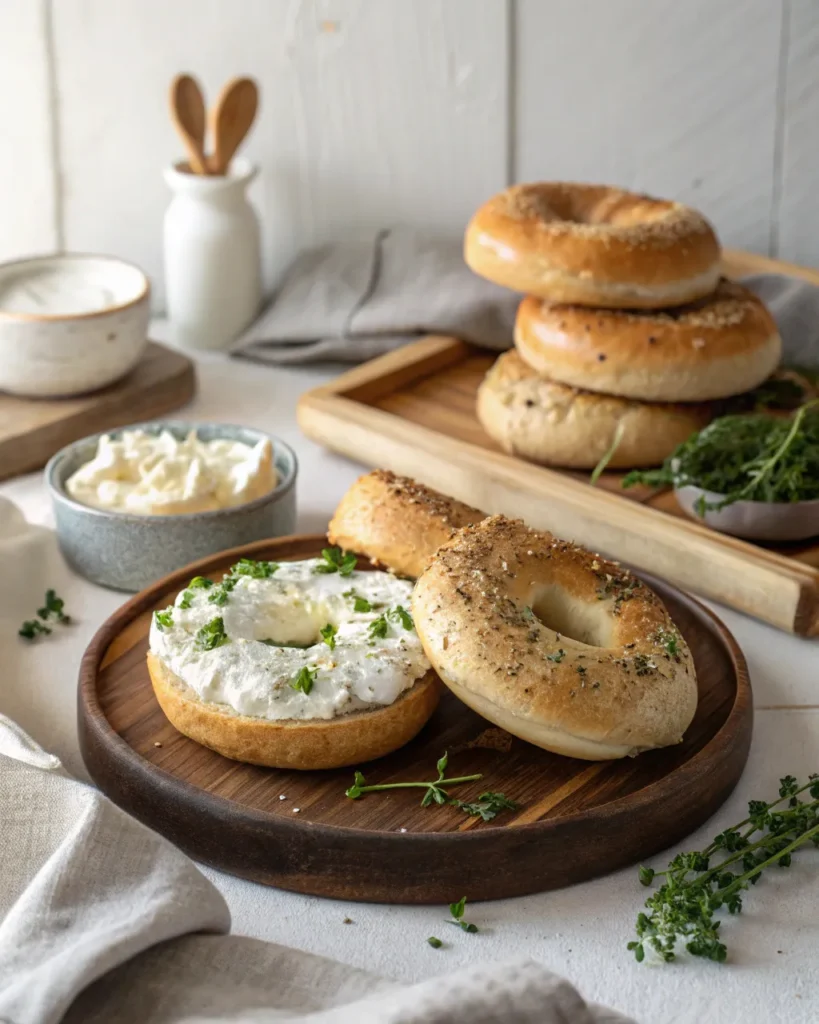
Let’s bring it all together: Cottage cheese bagels are a simple, practical recipe made for everyday life. They’re fast to prepare, high in protein, low in sugar, and delicious whether you prefer sweet or savory. No yeast, no rising, no hassle—just wholesome ingredients coming together in a way you’ll truly enjoy.
You don’t need to be a baker. You don’t need fancy ingredients. And you definitely don’t need to give up your health goals to enjoy a warm, soft, satisfying bagel.
Whether you’re meal prepping for the week, looking for a post-workout snack, or just want a better breakfast, this recipe has you covered. Once you try these, it’s hard to go back to store-bought.
If you loved this bagel recipe, don’t miss our cottage cheese cookie dough recipe — another high-protein, guilt-free treat.
Give it a go this weekend — and see how game-changing a bagel can really be.
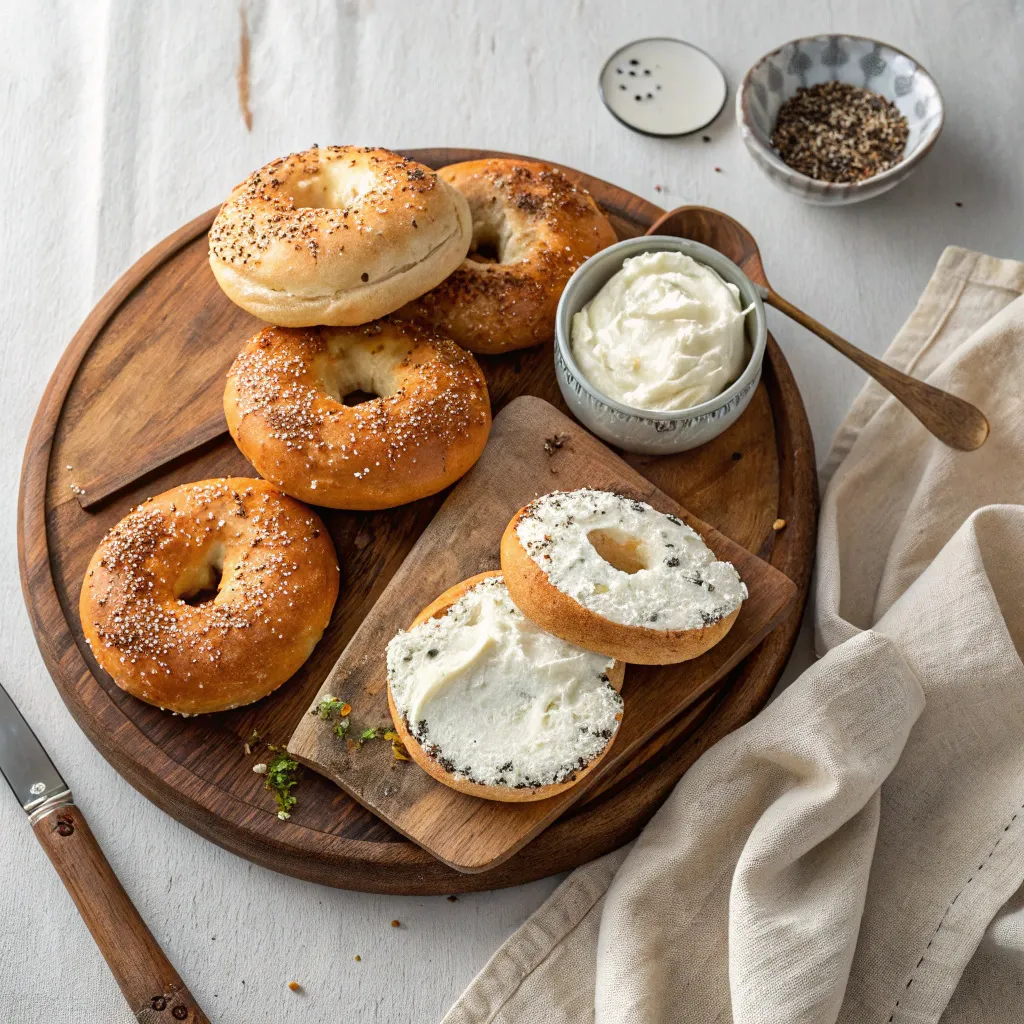
Cottage Cheese Bagels
Ingredients
Equipment
Method
- Preheat oven to 375°F (190°C). Line a baking sheet with parchment paper.
- In a bowl, whisk together flour, baking powder, and salt.
- Add cottage cheese and mix until a shaggy dough forms.
- Knead gently on a floured surface for 1–2 minutes.
- Divide dough into 4–6 pieces. Shape into balls and poke a hole through each.
- Beat the egg and brush over the tops. Add toppings if desired.
- Bake for 20–25 minutes until golden brown.
- Let cool for 5–10 minutes on a wire rack before serving.
Notes
These bagels are best enjoyed fresh but can be stored in an airtight container for 2 days or frozen for up to 3 months. Reheat in toaster or oven for best texture.
